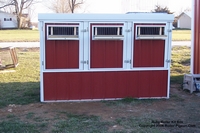Identify Early Landers
A frustrating problem for newer roller guys is when a young bird team does not want to stay up and fly past 10 or 15 minutes.  The development of the team is stunted and even some birds can develop bad habits that can ruin them as kit birds. The development of the team is stunted and even some birds can develop bad habits that can ruin them as kit birds.
In my experience I have seen the cause of this can often be a single bird. It can be a bird that is a slow eater and simply does not get enough of his share of the feed ration and is perpetually feeling overly hungry. It can also be an early developing roller that is also in need of more nutrition than what he is actually able to get while feeding with the kit.
This type of bird will often give you several minutes of airtime and then its “straight down to the loft”! Even shooing it back with loud claps, loud shouts or even tossed objects, etc. just does no good to keep the bird up. As a matter of fact these kinds of efforts quite often lead the bird to landing on a distant tree or telephone pole, or even a neighbors roof!
To add to this problem is when other kit birds follow them down leading to the kit breaking apart and potentially ruining what would otherwise be good kit birds if nothing is done to nip this bad behavior in the bud.
The easiest way to solve this problem is to identify the culprit and remove him from the kit. I have seen this work very effectively where the next day the kit flies 2 or even 3 times as long as before!
But what if you do not want to permanently get rid of the bird? Then it will take a bit of special care. The first thing is to keep it in for a few days and give it extra ration of protein. Try adding peas or even some pellets in the 14% to 16% protein range. Also, watch to see if the bird is mostly picking out low protein seeds like milo, if so then mix a ration that is low in carbohydrates and higher in protein. This will help build muscle and establish a nutritional basis for building flying stamina.
The next step is to hand toss him after the kit has already been flying and they are down to their last 10 or 15 minutes or so. This will start to process of the problem bird acclimating to flying WITH and COMING DOWN WITH the entire kit, not just by himself.
By following this advice you will solve 80% of the issues involving young bird aerial problems.
Tony Chavarria
|